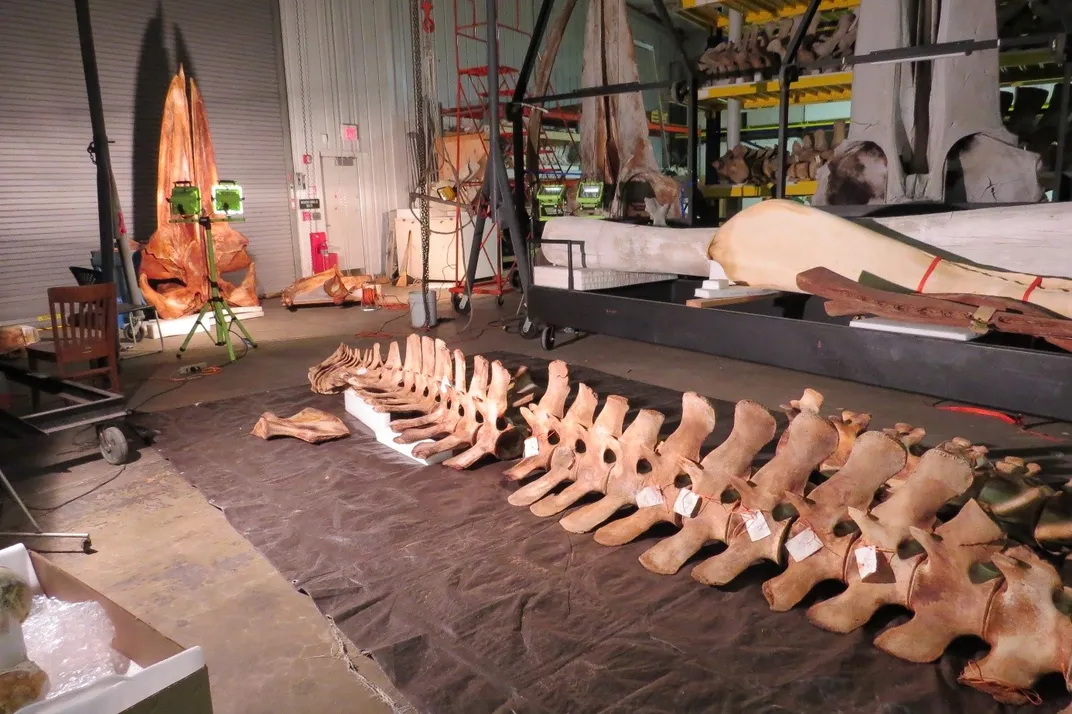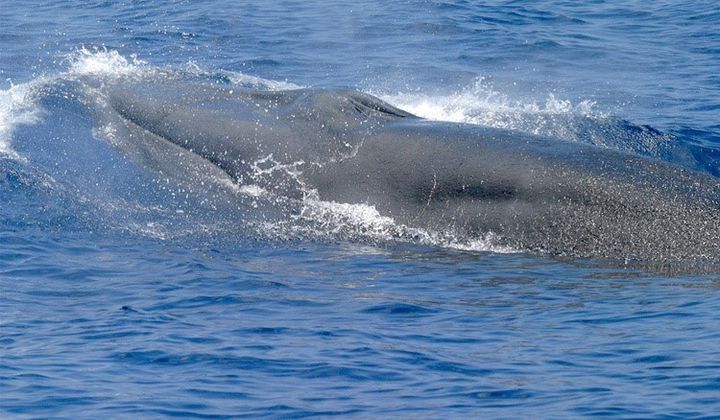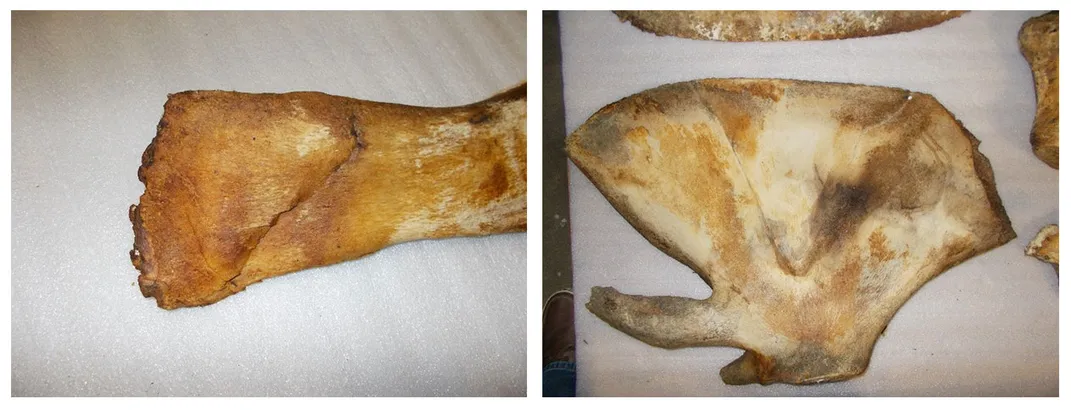NATIONAL MUSEUM OF NATURAL HISTORY
Scientists Describe New Species of Rare Bryde’s Whale
The study shows that the oceans still harbor many secrets that we might not realize we’re losing.
/https://tf-cmsv2-smithsonianmag-media.s3.amazonaws.com/blogging/featured/A_whale_on_the_surface_of_the_water..jpg)
In early 2019, a massive whale carcass washed up on a tourist beach in the Florida Everglades. The whale, measuring nearly 37 feet from tip to tail, was a rare Bryde’s (pronounced broodus) whale.
When Dr. Michael McGowen, curator of marine mammals at the Smithsonian’s National Museum of Natural History, and John Ososky, a museum specialist at the museum, heard about the corpse, they jumped on the phone to convince the National Oceanic and Atmospheric Administration (NOAA) to help preserve the whale.
NOAA agreed and later that year, the whale skeleton made its journey to the Smithsonian, where it is now a part of the National Museum of Natural History’s marine mammal collection. McGowen and Ososky knew from the beginning that this whale was going to be an important specimen. But, at the time, they didn’t know just how important.
In a paper published in the journal Marine Mammal Science in January, scientists discovered that the Smithsonian’s specimen is a new species related to the Bryde’s whale, making the skeleton a holotype — the specimen used to describe and define a species for the first time. The research team named the species Rice’s Whale (Balaenoptera ricei) after the prominent marine mammal biologist Dr. Dale Rice.
A whale of a win for diversity
This discovery is bigger than just a new species of whale. It shows that the oceans still harbor many secrets that we might not realize we’re losing.
“There is still so much undiscovered diversity in the ocean, and it could be disappearing before we discover it,” said McGowen. “The fact that one of the largest organisms could be identified as a new species means that the number of unknown smaller and less well-studied organisms is exponential.”

Rice’s Whales are critically endangered, with NOAA estimating that there are fewer than 100 individuals left in the wild. It is possible that it could have gone extinct before scientists realized it was a separate species.
The whale makes its home in the Gulf of Mexico, making it not only a new species, but also a new North American species. Its discovery is a whirlwind of rarities.
“This finding is a big deal because the discovery of a new baleen whale species rarely happens. Also, it is a large whale species that has such a small distribution: a small part of the Gulf of Mexico,” said McGowen. “Most whale species have much larger distributions, including many that exist in every ocean basin.”
It’s hard to imagine that a creature of this size could have slipped away right under our noses. But whale populations around the world continue to struggle. According to the World Wildlife Fund, six out of the 13 great whale species are classified as endangered or vulnerable. This new species shows that these giant ocean mammals are still not fully understood and we need to learn all that we can before they disappear entirely.
A bryde-ing question about diet
Scientists had already done some genetic work on Rice’s Whales before the Smithsonian’s specimen washed ashore in Florida. But the skeleton helped the paper’s authors study the morphology, or physical characteristics, of the whale to learn more about it.
“The genetics and morphology have now been integrated in this new paper,” said Dr. Patricia Rosel, a researcher with NOAA’s National Marine Fisheries Service and the lead author of the paper. “It provides multiple strong lines of evidence that these whales appear to be distinct from all closely related whales in the world.”

But there is still a lot more to learn about the whales. For Rosel, the first step is looking at the whale’s biology and ecology.
“We need to learn about where in the food web they are feeding and what their preferred prey is,” said Rosel.
Recent studies by NOAA scientists suggest that the whales eat lower in the water than their close relatives. According to Rosel, their relatives have been spotted eating more towards the surface of the ocean while the Rice’s Whale may prefer to eat closer to the sea floor.
This potentially unique feeding habit, if confirmed, will help scientists determine what the whales are eating and where they are going to get their food, which could illuminate the whale’s larger distribution and their movement patterns.
Knowing where Rice’s Whales feed and what they eat will help researchers better assess what is threatening the whales. From there, Rosel says they can develop more effective mitigation measures to protect the species.
A beacon of hope
While the Smithsonian’s specimen makes future research possible, Ososky hopes it will also be a beacon for increased conservation efforts.
The Gulf of Mexico presents many challenges for Rice’s Whale, with humans being the most substantial threat. Because the Gulf is a major shipping hub, ship strikes endanger the whale. In fact, the Smithsonian’s specimen shows evidence of a ship strike with a healed break in its scapula and one of its ribs.

Oil spills and noise and water pollution also prevent these whales from thriving. Ososky says that their specimen appears to have died from ingesting a large shard of plastic that ripped through its digestive system.
“[The Gulf] is not really a great place for a large whale to make a living,” Ososky said. “We can see why it’s in so much trouble.”
With so few individuals of this new species left in the wild, each one needs to be protected. But, Ososky worries that any effort to protect the whales would face significant pushback due to the well-established shipping routes in the Gulf of Mexico. He can only hope that this specimen being at the Smithsonian will shed light on the immediate protection that it needs.
“This [whale] is beyond just a scientific specimen. It’s a symbol,” Ososky said. “It’s a symbol of what we’ve done to our oceans. It’s a symbol of how America has developed, how we’ve changed the environment and the impact it’s had.
Related stories:
Saving This Rare Whale Skeleton was a Dirty Job
Rare Iridescent Snake Discovered in Vietnam
Shocking Study Finds Electric Eels Hunt Together
Scientists Describe New Bird Species 10 Years After First Reported Sighting

